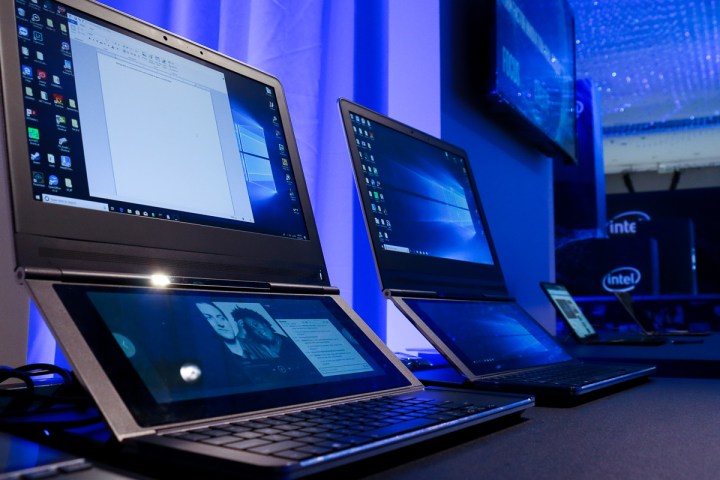
When Apple debuted its recent redesigned MacBook Pro with Touch Bar, it brought dual-screen laptops mainstream. What’s displayed on the narrow screen dynamically changes depending on the app you’re using, and the Touch Bar showed mainstream PC users that dual screens can help simplify workflows and deliver better usability. At this year’s Computex, Intel, and its partners are running with the dual-screen design, adding their own twists, and hoping that some of these ideas catch on for Windows users.
Intel showed off two concepts, which could show up on the market within a few years, and one of those ideas could turn a humble notebook into a stellar mobile gaming command center. For creatives, Asus’ ZenBook Pro Duo replaced Apple’s narrow Touch Bar display with a massive secondary 4K display over the keyboard, while HP showed off a more utilitarian laptop design that’s crafted from natural wood. Here are four of the most innovative — or weird — laptops that you’ll find at Computex.
Intel Twin Rivers Concept

Perhaps the closest near-commercial implementation to Microsoft’s original Courier concept, Intel’s Twin Rivers is a fabric-clad dual-screen device that’s designed to replace a magazine or book. The secondary screen actually replaces the entire keyboard deck, and here you will have access to two 12.3-inch display with a 3:2 aspect ratio and resolution of 1,920 x 1,280 pixels each. This isn’t a foldable in the same sense as Samsung’s Galaxy Fold smartphone, as the device relies on two independent panels for the displays.
To lean in and get work done, Intel also showed off a thin keyboard that you can place right on top of the bottom display. The remaining portion of the screen that remains exposed after the keyboard is situated can, through clever software, transform into a glass trackpad. In an early hands-on, Engadget complained that key travel was a bit short, but it’s still handy to be able to type on physical keys here, rather than pecking on glass, when working with on a long email or Word document.

The whole package is encased in fabric, making it feel like a larger book in the hands, and Intel is using a low-powered fanless design with its Dynamic Tuning processor technology to help keep things running smoothly and cool. For now, though, Twin Rivers is still a concept that manufacturers like Dell, HP, and Lenovo can take and add their own twists. For example, when they are commercialized, manufacturing partners can use lower powered displays to save battery life or add LTE or 5G connectivity.
Asus ZenBook Pro Duo

If two large glass panels on Twin Rivers is too much for you to handle, Asus’ ZenBook Pro Duo tones it down with a more traditional clamshell form factor. Like Apple’s MacBook Pro, you’re getting a Touch Bar-like secondary display right above the keyboard called the ScreenPad Plus. Boasting a 32:9 aspect ratio 4K display with a 14-inch screen size to complement the main 15.6-inch panel, ScreenPad Plus can be used to run apps, show tools, and as a canvas to interact with content.
Because of the size of ScreenPad Plus, the keyboard is shifted all the way to the bottom edge of the laptop, meaning that the trackpad on this device has been relocated to the right-hand side. The trackpad is also a ScreenPad, and an LED-illuminated number pad can be displayed if you’re working in Excel.
And unlike the concept Twin Rivers, the ZenBook Pro Duo is expected to ship at an unspecified date in the near future.
Intel Honeycomb Glacier Concept

Like the ZenBook Pro, Intel’s Honeycomb Glacier concept laptop incorporates a massive secondary touchscreen in a clamshell notebook form factor complete with keyboard. Here, Intel made some ergonomic improvements that make Honeycomb Glacier more comfortable to use, and this also makes the secondary display more useful.
Intel added a secondary hinge between the top of the keyboard and the bottom of the secondary panel to elevate the second screen. Whereas you’d have to hunch over the keyboard on the MacBook Pro or the ZenBook Pro Duo to see that second screen, the elevated screen position on Honeycomb Glacier makes it easier to see and interact with that panel. Both screens, here, are lifted thanks to a dual-screen, dual-hinge design.
“Intel is so proud of this hinge that it wouldn’t let us take pictures or video or the internal mechanism, but it works like this: When you lift the screen, it’ll automatically stay propped up to any angle of your choice thanks to a mechanical one-way roller clutch, and you press a little black button on the left side to disengage that clutch when you want to fold it down,” The Verge wrote.
While this makes it easy to access creative tools when using apps like Photoshop or Adobe Premiere, gamers can also benefit from a similar design with easy to view game tools, leaderboards, or other controls. Intel can also incorporate its Tobii eye-tracking tech here given that the second screen is almost at eye level.
HP Envy Wood Edition

Though this laptop lacks the hype of a dual-screen design, it may be the perfect fit for those chasing after mid-century modern aesthetics. The HP Envy Wood replaces the palm rest area surrounding the trackpad as well as the trackpad — areas that are traditionally cloaked in plastic, metal, or glass — with wood.
Users opting for the wooden edition of HP’s laptop will be able to choose between walnut and birch. This isn’t the first time that HP is showing its willingness to experiment with different material selections — last year’s Spectre Folio was clad in leather.


